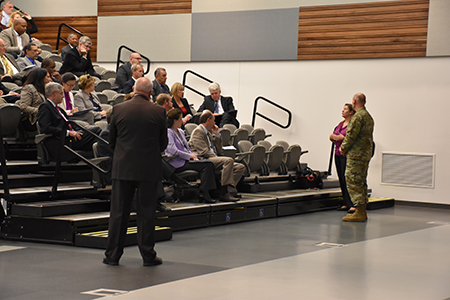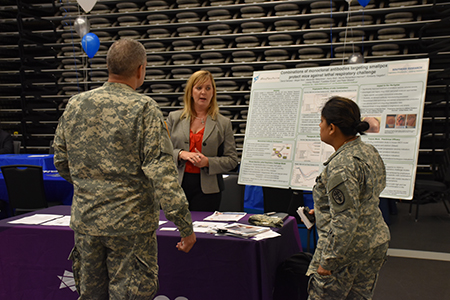MPRD Contractor Event Stimulates Collaboration


The U.S. Army Medical Materiel Development Activity and the U.S. Army Medical Research Acquisition Activity co-hosted a large gathering of product and project managers, contractors and subcontractors for their annual Marketing and Vendor Days event held at Fort Detrick, Maryland, Oct. 17-18. As subordinate commands of the U.S. Army Medical Research and Materiel Command, USAMMDA and USAMRAA have been working together to manage the USAMRMC's 10-year Medical Product Research and Development Contract, which was awarded July 31, 2015, as an Indefinite Delivery/Indefinite Quantity vehicle to support multiple research and development efforts throughout the command. Simply put, IDIQ contracts create the framework to provide an indefinite quantity of services during a fixed period of time, which allows for a myriad of potential opportunities over the life of the contract.
"An IDIQ contract provides a streamlined contracting approach," said Amy Brown, USAMMDA senior acquisition management liaison officer. "From the proposals we received for the base MPRD contracts, four vendors were selected as the prime contractors [DVC, Leidos, Inc., PPD, and TASC/Engility], and only these groups may now bid on task orders that come up during the contract period.
"This type of contract helps us to establish a much closer relationship with the particular vendors who are conducting the work for USAMRMC," said Brown. "We are here to help them better understand our contract requirements, which should help the vendors develop more solid proposals in the future."
In regard to USAMRMC, much of its R&D work includes clinical and non-clinical studies, investigational product manufacturing and testing, regulatory affairs, acquisition support services, sustainment planning, and reliability, availability and maintainability in support of efforts to create U.S. Food and Drug Administration-approved pharmaceuticals, biologics and devices, as well as other medical products not regulated by the FDA. Task orders that arise may involve the total development effort, or only partial effort for specific segments along the product development lifecycle.
"The purpose of this event is to inform the prime vendors and their respective subcontractors of the upcoming missions and the mission space," said Brown. "We can provide a general overview of key areas, but no specific information at this time – but this still helps them with the contract forecast."
In order to expedite proposal turnaround and the awarding of contracts, the MPRD contract forecast provides the four prime vendors with sufficient information far ahead of the release of task orders, so that each can establish the appropriate team of subcontractors to effectively perform the given task.
USAMRAA contracting officer Barry Sayer is in charge of managing the MPRD contract, and he plays a key role in encouraging open communication between the customer, vendor and contracting office.
"The primary goal of getting everyone together is to stimulate more task actions to award under this MPRD contract, as well as to help produce stronger, more cost-effective proposals" said Sayer. "We want to make sure the contractors clearly understand our mission and our capabilities, and our gaps in capabilities, which we can use them to help fill.
"In the past, USAMRMC and other Department of Defense medical product developers have utilized various contract vehicles to support medical product R&D efforts," continued Sayer. "However, with this MPRD contract, we are using a more standardized approach to promote enhanced industry engagement, as well as accelerated contract awards, funding obligation and disbursements."
Sayer said that the feedback he received from the attendees was very positive, which goes quite a long way in a situation where cooperation is paramount.
"Yesterday, we tried something new by offering presentations by the commanders and subordinate commands, and the participants said this was very beneficial," said Sayer. "They said it definitely added value to the Vendor Day session, and it helped them to better understand what we're trying to accomplish with this MPRD contract – and how they can contribute to its success."
In terms of contributing, Sayer certainly welcomed the exchange of thoughts and ideas during his presentation to the attendees, in which he encouraged the group to provide suggestions for a proposal template to help standardize submission documents, in addition to those currently in use.
Sayer stated, "We hope to create an efficient tool for proposal submission, almost 'fill-in-the-blank,' so that both the customer and the contractor can immediately recognize the required information and turn this around quickly. If we can standardize the written documentation, this will certainly help speed up the submission process for all involved."
As a long-term, strategic contract, the MPRD vehicle is being utilized to create contracting and administrative efficiencies across the DOD medical product development enterprise. Sayer certainly recognizes the benefits gained from its use, as do many others throughout the USAMRMC.
Kathleen Berst, USAMMDA deputy commander for acquisition, sees great value in the utilization of the MPRD contract, especially with regard to advancing critical products to our Warfighters in the field.
"Contracts under the MPRD vehicle are strategic contacts to support all aspects of medical product development," said Berst. "They are important to USAMMDA because they allow us to streamline our acquisition process and access world-class partners to accelerate development and deliver of new capabilities to our Service Members."
Sayer said they look forward to planning next year's Marketing and Vendor Days event, and he hopes to receive many new opportunities via the MPRD contract throughout the upcoming year.
"I encourage people to contact me, or Amy Brown, at any time with questions," he said. "The MPRD is a great vehicle, and it covers the entire gamut of R&D for medical products. The four prime contractors have all been vetted and are prepared for new work at any time – and with their teams of subcontractors, they can do anything and everything that we would need done."













